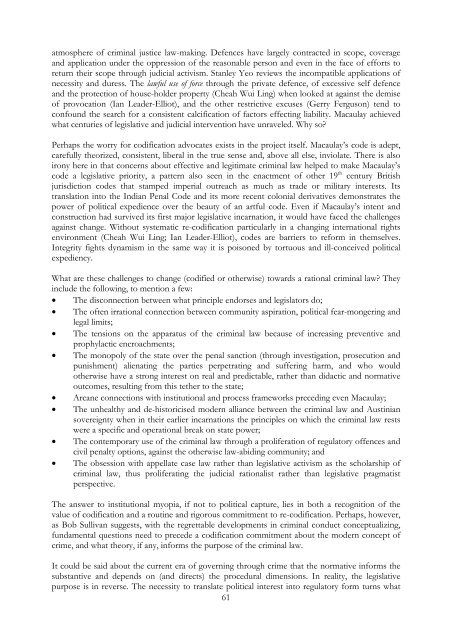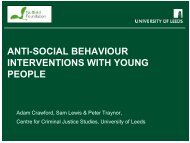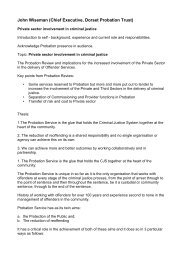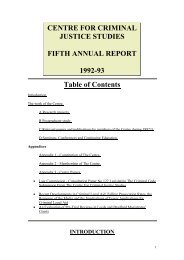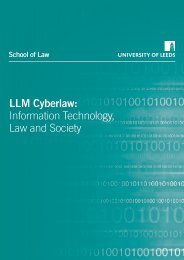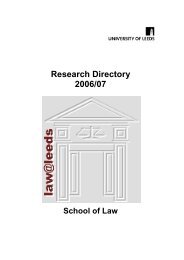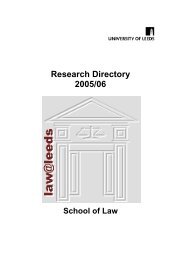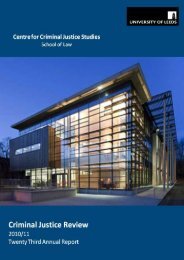Perceptions of Security and Reassurance at the ... - School of Law
Perceptions of Security and Reassurance at the ... - School of Law
Perceptions of Security and Reassurance at the ... - School of Law
Create successful ePaper yourself
Turn your PDF publications into a flip-book with our unique Google optimized e-Paper software.
<strong>at</strong>mosphere <strong>of</strong> criminal justice law-making. Defences have largely contracted in scope, coverage<strong>and</strong> applic<strong>at</strong>ion under <strong>the</strong> oppression <strong>of</strong> <strong>the</strong> reasonable person <strong>and</strong> even in <strong>the</strong> face <strong>of</strong> efforts toreturn <strong>the</strong>ir scope through judicial activism. Stanley Yeo reviews <strong>the</strong> incomp<strong>at</strong>ible applic<strong>at</strong>ions <strong>of</strong>necessity <strong>and</strong> duress. The lawful use <strong>of</strong> force through <strong>the</strong> priv<strong>at</strong>e defence, <strong>of</strong> excessive self defence<strong>and</strong> <strong>the</strong> protection <strong>of</strong> house-holder property (Cheah Wui Ling) when looked <strong>at</strong> against <strong>the</strong> demise<strong>of</strong> provoc<strong>at</strong>ion (Ian Leader-Elliot), <strong>and</strong> <strong>the</strong> o<strong>the</strong>r restrictive excuses (Gerry Ferguson) tend toconfound <strong>the</strong> search for a consistent calcific<strong>at</strong>ion <strong>of</strong> factors effecting liability. Macaulay achievedwh<strong>at</strong> centuries <strong>of</strong> legisl<strong>at</strong>ive <strong>and</strong> judicial intervention have unraveled. Why so?Perhaps <strong>the</strong> worry for codific<strong>at</strong>ion advoc<strong>at</strong>es exists in <strong>the</strong> project itself. Macaulay’s code is adept,carefully <strong>the</strong>orized, consistent, liberal in <strong>the</strong> true sense <strong>and</strong>, above all else, inviol<strong>at</strong>e. There is alsoirony here in th<strong>at</strong> concerns about effective <strong>and</strong> legitim<strong>at</strong>e criminal law helped to make Macaulay’scode a legisl<strong>at</strong>ive priority, a p<strong>at</strong>tern also seen in <strong>the</strong> enactment <strong>of</strong> o<strong>the</strong>r 19 th century Britishjurisdiction codes th<strong>at</strong> stamped imperial outreach as much as trade or military interests. Itstransl<strong>at</strong>ion into <strong>the</strong> Indian Penal Code <strong>and</strong> its more recent colonial deriv<strong>at</strong>ives demonstr<strong>at</strong>es <strong>the</strong>power <strong>of</strong> political expedience over <strong>the</strong> beauty <strong>of</strong> an artful code. Even if Macaulay’s intent <strong>and</strong>construction had survived its first major legisl<strong>at</strong>ive incarn<strong>at</strong>ion, it would have faced <strong>the</strong> challengesagainst change. Without system<strong>at</strong>ic re-codific<strong>at</strong>ion particularly in a changing intern<strong>at</strong>ional rightsenvironment (Cheah Wui Ling; Ian Leader-Elliot), codes are barriers to reform in <strong>the</strong>mselves.Integrity fights dynamism in <strong>the</strong> same way it is poisoned by tortuous <strong>and</strong> ill-conceived politicalexpediency.Wh<strong>at</strong> are <strong>the</strong>se challenges to change (codified or o<strong>the</strong>rwise) towards a r<strong>at</strong>ional criminal law? Theyinclude <strong>the</strong> following, to mention a few:• The disconnection between wh<strong>at</strong> principle endorses <strong>and</strong> legisl<strong>at</strong>ors do;• The <strong>of</strong>ten irr<strong>at</strong>ional connection between community aspir<strong>at</strong>ion, political fear-mongering <strong>and</strong>legal limits;• The tensions on <strong>the</strong> appar<strong>at</strong>us <strong>of</strong> <strong>the</strong> criminal law because <strong>of</strong> increasing preventive <strong>and</strong>prophylactic encroachments;• The monopoly <strong>of</strong> <strong>the</strong> st<strong>at</strong>e over <strong>the</strong> penal sanction (through investig<strong>at</strong>ion, prosecution <strong>and</strong>punishment) alien<strong>at</strong>ing <strong>the</strong> parties perpetr<strong>at</strong>ing <strong>and</strong> suffering harm, <strong>and</strong> who wouldo<strong>the</strong>rwise have a strong interest on real <strong>and</strong> predictable, r<strong>at</strong>her than didactic <strong>and</strong> norm<strong>at</strong>iveoutcomes, resulting from this te<strong>the</strong>r to <strong>the</strong> st<strong>at</strong>e;• Arcane connections with institutional <strong>and</strong> process frameworks preceding even Macaulay;• The unhealthy <strong>and</strong> de-historicised modern alliance between <strong>the</strong> criminal law <strong>and</strong> Austiniansovereignty when in <strong>the</strong>ir earlier incarn<strong>at</strong>ions <strong>the</strong> principles on which <strong>the</strong> criminal law restswere a specific <strong>and</strong> oper<strong>at</strong>ional break on st<strong>at</strong>e power;• The contemporary use <strong>of</strong> <strong>the</strong> criminal law through a prolifer<strong>at</strong>ion <strong>of</strong> regul<strong>at</strong>ory <strong>of</strong>fences <strong>and</strong>civil penalty options, against <strong>the</strong> o<strong>the</strong>rwise law-abiding community; <strong>and</strong>• The obsession with appell<strong>at</strong>e case law r<strong>at</strong>her than legisl<strong>at</strong>ive activism as <strong>the</strong> scholarship <strong>of</strong>criminal law, thus prolifer<strong>at</strong>ing <strong>the</strong> judicial r<strong>at</strong>ionalist r<strong>at</strong>her than legisl<strong>at</strong>ive pragm<strong>at</strong>istperspective.The answer to institutional myopia, if not to political capture, lies in both a recognition <strong>of</strong> <strong>the</strong>value <strong>of</strong> codific<strong>at</strong>ion <strong>and</strong> a routine <strong>and</strong> rigorous commitment to re-codific<strong>at</strong>ion. Perhaps, however,as Bob Sullivan suggests, with <strong>the</strong> regrettable developments in criminal conduct conceptualizing,fundamental questions need to precede a codific<strong>at</strong>ion commitment about <strong>the</strong> modern concept <strong>of</strong>crime, <strong>and</strong> wh<strong>at</strong> <strong>the</strong>ory, if any, informs <strong>the</strong> purpose <strong>of</strong> <strong>the</strong> criminal law.It could be said about <strong>the</strong> current era <strong>of</strong> governing through crime th<strong>at</strong> <strong>the</strong> norm<strong>at</strong>ive informs <strong>the</strong>substantive <strong>and</strong> depends on (<strong>and</strong> directs) <strong>the</strong> procedural dimensions. In reality, <strong>the</strong> legisl<strong>at</strong>ivepurpose is in reverse. The necessity to transl<strong>at</strong>e political interest into regul<strong>at</strong>ory form turns wh<strong>at</strong>61


